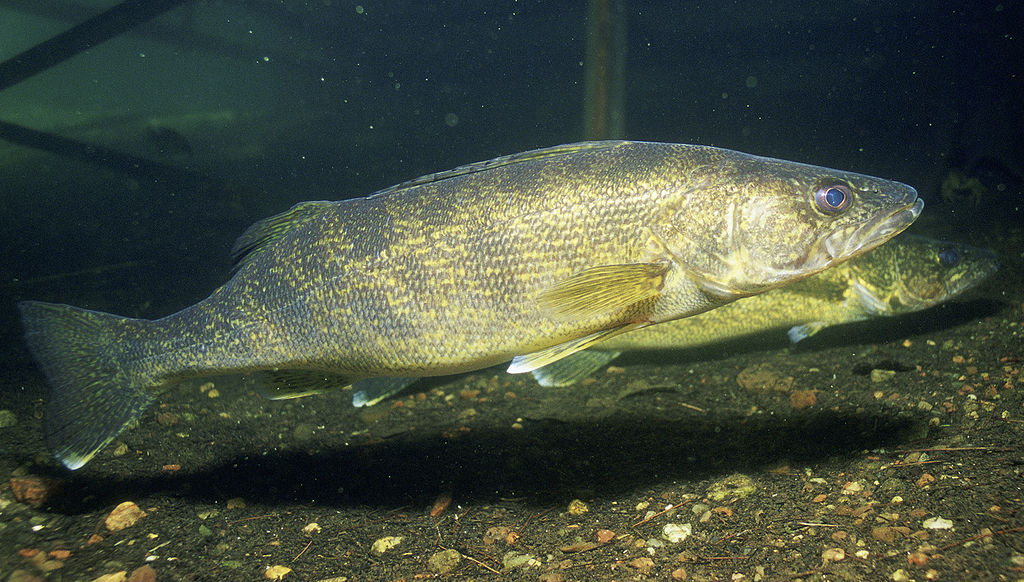
Walleye
Scientific Name: Sander vitreus
Also known as: Yellow Pike, Sand Pike, Walleyed Pike, Great Lake Walleye, and Marble Eye
General Description
The walleye is a popular freshwater fish prized for its delicate flavor and the challenge it presents to anglers. Recognizable by its large, glassy eyes, which are well-adapted for low-light conditions, the walleye typically has a pale, olive-green body with a white belly and distinct dark vertical bands. These features make the walleye one of the most identifiable fish in North America’s freshwater lakes and rivers.
A predatory species, walleyes are known for their elusive behavior, often hiding in deeper waters during the day and becoming more active at dawn and dusk. They have a lean, torpedo-shaped body, enabling them to swim swiftly through the water while hunting for their prey, which consists of smaller fish, minnows, and invertebrates.
Walleye typically range in size from 15 to 20 inches, with the potential to reach lengths of up to 30 inches and weights of several pounds. As one of the most sought-after sportfish in North America, walleye offer anglers a combination of beauty, challenge, and culinary rewards, making them a top choice for fishing enthusiasts.
Where to Find Them
Walleyes are widely distributed across North America, inhabiting both lakes and rivers. They are commonly found in the Great Lakes, large reservoirs, and many midwestern and northeastern river systems. Walleye populations can also be found in Canada, particularly in the provinces of Ontario, Quebec, and Manitoba.
Walleyes are known to prefer cool, clear waters, and they tend to live in deeper areas during the day. They are often found near the bottom of lakes or rivers, especially in areas with rocky structures, submerged vegetation, and sandy or gravelly bottoms. During the warmer months, they may move to deeper, cooler waters during the midday but will often come closer to shore during dawn and dusk to feed.
In rivers, walleyes are typically found near deeper pools, drop-offs, and around submerged rocks or logs where they can ambush smaller fish. During the spawning season, they tend to move upstream to gravel or rocky spawning beds, where water temperatures are cooler. These spawning locations provide perfect conditions for young walleyes to develop before they move back into deeper waters.
In lakes, walleyes are frequently found near ledges, drop-offs, and underwater points, particularly in waters with low to moderate current. Their preference for clear waters and deeper regions often means that they are most active during low-light conditions, making fishing for walleye in the early morning or late evening ideal.
Best Baits
Live Bait Options
- Minnows (especially shiners and fathead minnows)
- Nightcrawlers
- Leeches
- Small sunfish
- Crayfish
Artificial Bait Options
- Jigs (especially tipped with minnows or worms)
- Crankbaits (shad or minnow imitations)
- Soft plastics (worms, grubs, and swimbaits)
- Spinners
- Rattlebaits (in deeper waters)
Best Fishing Methods
Walleye are known for their cautious, predatory nature, often feeding in deeper waters, which makes them a challenge to catch. The best fishing methods for walleye include slow and steady techniques that mimic the movement of natural prey. Trolling is an effective method, especially when using crankbaits or spinners. This allows anglers to cover a large area of water while adjusting the depth at which the bait is presented. Jigs, especially those tipped with live minnows or worms, can be effective when fished near the bottom or in deeper, structure-heavy areas.
Casting with soft plastics or swimbaits is another excellent method for walleye fishing, particularly in areas where fish are actively feeding along the bottom. These lures imitate small fish and can be worked slowly to entice strikes from cautious walleye.
In river fishing, walleye are often found near drop-offs, submerged rocks, and structures. Here, anglers can employ bottom-bouncing rigs with live bait to target walleye that are positioned near the riverbed. The key to successful walleye fishing is to fish during low-light conditions, such as dawn or dusk, when the fish are most active and willing to feed.
During the winter months, ice fishing is another popular method for catching walleye. This method involves drilling a hole in the ice and using jigs or live bait to attract walleye beneath the surface. Fishing deeper waters where walleye congregate, particularly in lakes with cold temperatures, is essential to success.
Summary
Walleye are a prized catch for anglers who enjoy a challenge and the reward of a delicious meal. These predatory fish are known for their elusive nature, making them a thrilling target for sport fishermen. With their large, reflective eyes, walleyes are adept at hunting in low-light conditions, which is why they are most active at dawn and dusk.
Fishing for walleye requires patience and skill, as these fish tend to inhabit deeper waters during the day and are most active in low-light conditions. The best fishing techniques involve using slow-moving baits that imitate minnows or other small fish, such as jigs, crankbaits, and spinners. Live bait, like minnows and nightcrawlers, is also highly effective, especially when fished near the bottom in deeper, rocky or gravelly areas.
Walleyes are found in a wide variety of freshwater habitats across North America, from lakes to rivers, with a particular preference for cool, clear waters. They can be found in the Great Lakes, large reservoirs, and rivers throughout Canada and the United States. Whether fishing from a boat or from the shore, anglers can increase their chances of success by targeting deeper water areas where walleyes are likely to be hiding.
As one of the most sought-after game fish in North America, walleye offer anglers a thrilling fishing experience. Their elusive nature and strong predatory instincts make them a challenge to catch, but the rewards are well worth the effort.


